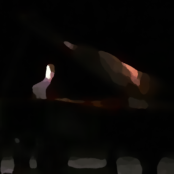Search the Community
Showing results for tags 'symphony'.
-
Hi everyone, I’m new here! I’ve seen a few other pieces of music shared here, and it seems like the perfect place for me to join in. I’m a French student, and I’ve spent 12 years studying piano at a conservatory. Recently, I’ve started composing, and I feel confident enough about what I’ve created to share it with you. Right now, I don’t have anyone around for active listening, so I have no idea how to assess the quality of my compositions. I’d really appreciate honest feedback (whether it’s theoretical or just based on your feelings) to understand where I stand and how I can improve. I hope you will feel as much emotion listening to it as I did composing it 😀 Thank you in advance for your time and your insights! The orchestral songs are Paper Symphony part 1&2 only (the others are in others style)
- 2 replies
-
- 1
-

-
- soundtrack
- symphony
-
(and 2 more)
Tagged with:
-
So anyway, the last time I tried to write a symphony was almost 8 years ago, and it was so terrible that it's now called Symphony No. 0 and we never speak of it. I was 15 at the time. I suppose (most) teenagers aren't generally known for writing great symphonies. But I recently tried again. This is now my Symphony No. 1. I just finished it today. It's in one vast, slow through-composed movement. I wonder if, as you listen, it is obvious who my main stylistic influences were. The entire piece is built from one motif, the three-note figure that bookends the whole thing of the rising leap followed by the falling step. I've been working on this for about six months. This symphony was the product of a lot of experimentation and often changing course on the fly. Not only have I never written this much slow music all at once before, but these are the largest orchestral forces I've ever handled, with the greatest variety of orchestral color at my disposal. It's also the first time in a while I have allowed myself the luxury of a harp, as previously I had always been wary of giving myself the opportunity to commit any of a number of common orchestration blunders. I'm enjoying the fruits of the new Muse Sounds I have gained access to by virtue of switching to Musescore. They're wonderful. They can be a bit buggy, but sometimes it's almost scary how human they sound. Curious about how this will be received.
-
After a good long while of waiting for the ideas to come back, here we are! I'm rather proud to announce the completion of my symphony's first movement. It's been a good long while since I last posted about progress on this symphony, and I think it's about time I broke the ice and post the finished product here. I'm fully intending on finishing this symphony by the end of the next two years or so, but I'm taking a break from symphonic writing for now (because it drains my will to compose like no other). I'll be returning to form and focusing on writing for smaller ensembles (and piano covers!) while waiting for the ideas to start emerging for the second mvt. to this symphony, so hopefully I'll be able to post more after this. That being said, this piece is obviously far from truly finished: it's only a quarter of the struggle, after all. I'll be looking forward to reading all of your comments and criticisms as per usual. I can't wait to get through them all! (Also, to@Henry Ng Tsz Kiu: I owe this one to you! 😁)
- 10 replies
-
- 2
-

-

-
- symphony
- 1st movement
-
(and 1 more)
Tagged with:
-
I know I haven't finished symphony 2 or 3, but I was just so inspired by the material, I had to work on it. This is probably my most traditional (especially in structure) symphony so far, probably due to my analysing Beethoven symphonies and sonatas, reading sonata theory, and studying Fux's treatise on counterpoint. The movements are a sonata form first, followed by a scherzo, then the slow movement. There's a program, but it doesn't affect the music much, (introduction and exposition as well as the overall character of the inner movements are as far as the program goes). A rundown of the program: A few years ago, I found on my garage floor an abandoned, injured baby mouse. I wanted to rescue it, but my mom refused to do anything about it, and I was so distraught. I had never felt this way, knowing that I had the power to help the little creature, but being too afraid to go against my mother. I eventually disobeyed her, and I called a local animal rescue group. I sat with the mouse for hours to keep him company until she arrived. She took care of him and sent me update pictures until it was time for him to be released. She gave the mouse to me since I had found him, which I'm grateful for. I released him by an apple tree, and I sometimes regretted not keeping him, but I know he was probably content in the wild and my mother would not have approved anyway. The whole experience affected me deeply, even though looking back people have been in much more extreme animal rescue situations. And maybe my music is a bit melodramatic for this, but I sketched the intro and exposition immediately afterward, so the emotion was still fresh and raw. Specific program notes: The introductory crash represents my surprise when I first found him. The English Horn melody is the mouse, and the first and second theme are sad and then angered, because I was first sad for the mouse would likely die, and then angry because I was restricted from helping. The rest is absolute music and just develops the material. The middle movements are lighter because they represent the period where he was being taken care of. I have no idea what to do for the fourth movement, so I'll probably leave it for now and work on my other music. Also, sorry for the somewhat low-quality audio, I don't have too many opportunities to MuseScore 4, (it's on my parents' computer, my laptop can't handle it). (This is an expansion from a previous version linked here.)
-
In my school, when we enter into a new curriculum (by 11th grade), we're supposed to do something that we've never done before in order to strengthen and expand our understanding of the world around us (for those who may be in the know, I'm doing CAS for the IBDP programme next academic year). Being a composer, I decided to aim big and write a symphony. This is something I have truly never done before: not only is it a frightfully massive undertaking given how relatively new I am to composition, it is coupled with the fact that I'll be much busier next year than I have ever been (IBDP is known to do that). As a result, I've decided to take on this project the same way as I normally would with big, many-month assignments like this: I plan for them. This is what I've come up with so far for the first movement of this symphony: Opening fanfare on str.; intro to 1st mvt (Cm) → Enters principal theme; exposition (Cm) → Proceeds to development; 2nd theme is introduced (Fm → noodle around circle of fifths → F) Return to shortened opening; joins back into the introduction (Cm) → Re-development of previous themes into a 3rd theme (Dm → Fm → Fm7?) → Abridged opening, mixing with principal and 3rd theme; recapitulation of developed ideas (Cm) → Coda (Cm) Knowing full well that there are loads of musicians here who can definitely give me a hand, I want to know whether this is structure could suffice in powering a full symphonic orchestra, if it'll even work as a competent structure at all. I was gunning for a traditional sonata-allegro form, and I'm just going from what I know about symphonies and other large orchestral works regarding how sonata-allegro form works. If anybody's willing to look at it and give me advice, I'm all ears. Thank you!
- 26 replies
-
- help!
- first movement
-
(and 2 more)
Tagged with:
-
(I'm reposting here because I do not consider this a draft, though I will consider changing it after I'll get feedback) This is the first movement to my first symphony. Drafts have been posted here: Symphony in F minor.pdf Symphony in F minor.mp3
- 8 replies
-
- 2
-

-
- orchestra
- movement 1
-
(and 1 more)
Tagged with:
-
(There are three first movement drafts on this thread, and the first movement has been posted here for feedback, for second movement drafts scroll down) Hi! I am writing this "Symphonia Triumphalis" (Triumphant Symphony) and I decided to share the draft of the intro+expo. Some possible feedback I'd like to get: Did you like the piece personally overall? I would be glad if you highlighted your favorites and least favorites. What did you think of the orchestration? What did you think of my use of motives and themes? Any other feedback you'd like to give. Suggestions for the dev or the recap - some things you think could work.Symphonia Triumphalis.pdf Symphonia Triumphalis.mp3
-
Hey everyone! Sorry I've been absent from these forums for a while focusing on school work and... writing a symphony! I started writing this work back in November 2022, beginning with the 3rd movement (the Adagio Molto), and have been toiling away at it ever since. The work is a semi-autobiographical programme symphony with great influence from the likes of Beethoven (daddy😏), Mahler and Berlioz. It tells the story of a Protagonist who travels to America from Europe, meets a young woman, falls in love, leaves America, becomes depressed, returns later in life and marries her. My favourite bit is the 3rd movement- the funeral march- because it is the most idiiomatic and most effectively communicates my message. Plus I spent almost all of my time on it. This symphony is close to being done, what I'm sharing is my third full draft. Some of the openings, transitions and endings still need to be reworked, and I'm sure there are plenty of notation errors that I've missed, as well as more articulation markings etc to add. I'd be grateful for any constructive criticism on the musical and non-musical side as this will form part of my portfolio for conservatoire application here in the UK. Also tell me what you like (if there is anything). I have attached the score in pdf, the sibelius sounds rendering in mp3 and a sample of the programme in pdf. I look forward to seeing what you have to say, and to review more work on these forums again myself! -Charles
-
Hi forum, You'll find below the second movement of my third symphony (1st movement in another previous post). Have a nice day 🙂
-
Hi 🙂 I present you the first movement of my new symphony ; hope you'll like it. https://on.soundcloud.com/zctEc
-
Over half a year ago I posted the introduction of my second symphony that I've been working on since mid-2021 on this forum. I got some pretty good feedback, so what I'm sharing here is the changes I've made since then plus new stuff. I will also explain the structure of the whole piece. It is in one movement. The structure is kind of two tragic sonatas intertwined. I have an introduction, exposition 1, development 1, exposition 2, development 2, recapitulation of all themes, coda. And if any of you don't know what tragic sonata form is, it's just sonata form but the order of the themes in the recapitulation is reversed. So, the recapitulation of mine will be theme 4, 2, 3, and then one. I have gotten the introduction, first exposition, and first development to a point I'm comfortable sharing. btw I will not be putting this into musesounds until I'm done with the whole piece, since it takes a long time to do that. I'm especially wanting to improve the orchestration, counterpoint, and (sorry if this is vague) subtlety. Feedback is greatly appreciated and don't be afraid to be critical, it will most likely be of help.
- 5 replies
-
- 1
-

-
- symphony
- unfinished
-
(and 1 more)
Tagged with:
-
I thought I'd post my first symphony on here to see what people thought. The piece is finished, so any feedback you give, know that it won't be changed. Thanks for listening!
- 10 replies
-
- 1
-

-
- symphony 1
- symphony
-
(and 1 more)
Tagged with:
-
Hi! It's a big topic, but in general, how different is composing a symphony instead of for example a chorale harmonization piece? Do the same rules apply, just that different instruments have different restrictions/advantages? Or is it a hole new world of rules etc.? I appreciate any answers :nod: :D
-
Long time no see! I've recently been composing again and I'm very happy with this one. Structure resembles sonata form: Exposition: 0:00 A is polychords from F, C and G Lydian. 1:40 B is dobled melodies from polychords of G, Bb and Db Dorian. 2:52 C is textures from polychords of B, C and C# Locrian. Development: 1. 4:12 a few A tutti chords to close the exposition and open the development 2. 4:26 A+B juxtaposed 3. 4:58 A+C juxtaposed 4. 5:38 A+B+C tensely juxtaposed 5. 6:33 A+B+C integrated resolutely in a "collective agreement" mode based on E Lydian, ending in a little cello solo epilogue. Recapitulation: 8:14 order C-B-A Using Noteperfomer, warning: still loud but more balanced. Positive feedback revolves around the beauty of the harmony, orchestration and the interesting form. Criticisms I've received are that: It may be difficult to follow because the lack of literal repetition of an entire theme. A lacks a theme proper. The exposition and recapitulation of A and B lack contrapuntal interest. The harmonic rhythm is slow throughout. The lack of other movements I'm creating a version with a larger orchestra considering the criticisms, may even do a theme and variations second movement.
- 5 replies
-
- 1
-

-
- impressionism
- symphony
-
(and 1 more)
Tagged with:
-
Good afternoon fellow composers! I am very excited to present my latest large scale work, the first movement of my Symphony No. 1. My plan for the symphony is for it to be a “complete concert experience” with two large scale movements surrounding two shorter and lighter movements. This first movement is thus quite long, clocking in at a little over 27 minutes. It is intended to be almost a “symphony within a symphony”, preparing tension to be resolved later in the work, while still functioning as a standalone piece in its own right. I had a few goals in mind as I composed this, feel free to evaluate how well I achieved them: Focus on simple, memorable themes and motives Write a large scale opening symphony movement that could also function as a standalone piece Build a large movement on the development of two simple motives, specifically Motive 1 - a sequential 5th motive, first in the bass clarinet and bassoon at the beginning Motive 2 - an alternating ascending, descending motive, first in the low winds/strings and English horn/saxophone in the B section Integrate euphonium and saxophone into the orchestra Make use of auxiliary brass The movement is structured as a Rondo (A-B-A-C-A-D-A-B-A-coda), albeit with several creative liberties taken. Since it is quite long I’ve broken it down into several smaller sections if you prefer to only listen to a small piece. The structure is detailed below: 00:00 - A section - the piece begins quietly with sustained notes in the basses, with the low winds introducing Motive 1. This is repeated and embellished by the oboe and others 1:38 - B section - the broad opening theme gives way to a heavy and ominous pulse in the low strings and woodwinds. Motive 2 is introduced here first in the English horn and saxophone, then expanded and embellished, and leads up to a climax 4:46 - the A section returns, this time building into a brassy fanfare, but left unresolved. This section ends with a lively cacophonous polyrhythmic buildup that develops Motive 1 and leads into the next section 6:56 - the C section opens with a contrapuntal section, which utilizes and expands Motive 2 within octatonic scales that plane between each other, then leads into an ominous ascending theme (an inversion of Motive 2) that climaxes with a fiery rhythmic dance in frequently changing time signatures, this is repeated, then interrupted by a quiet irregular heartbeat in the harp and celesta, that eventually erupts before returning to the opening contrapuntal figure, this time in the woodwinds 11:05 - the A section theme returns briefly, this time as stacked fifths in the brass, and stated explicitly by the muted horns 11:45 - the D section begins with a lyrical theme in the English horn (formed by combining and rearranging Motive 1 and Motive 2), which is passed back and forth between the saxophone and bassoon. The texture slowly winds down, allowing a woodwind choir to emerge. The mood is bleak, but the strings enter and the mood shifts suddenly to hopeful and optimistic, before an epiphany is reached. The key returns to C major for one more buildup to the climax, with the brass exclaiming Motive 1, this time in a major mode. 15:50 - formal return to the A section, with mostly the same structure but the instrumentation is varied 17:27 - formal return of B section, this time a quiet horn solo prepares a fast whirlwind of a climax, before coming to a halt and preparing for the return to… 21:37 - the A section fanfare returns, this time enhanced by auxiliary brass. The climax is more resolved, but still leaves something wanting before the cacophony from earlier in the movement leads into the coda 24:09 - Coda - the ominous ascending theme returns here and is used to build tension along with distortions of the fiery dance from the C section. The irregular heartbeat returns as well, and leads into a chaotic polyrhythmic volcano that over flows into the final statement of the two motives overlaid on top of each other, traded back and forth between the auxiliary brass and the orchestra As usual, I have several questions for feedback, feel free to answer as many or as few as you wish: What effect does the music have on you? Does in conjure up an image? Or an emotional feeling? Does it tell you a story? This can be the piece as a whole, or a specific part or parts. What was your favorite part? What was your least favorite part? Does this work well as the first movement of a symphony? How about as a standalone piece? How well do you think the motives are developed? Do you have any comments or critiques on technique, e.g. harmony, melody writing, counterpoint, orchestration, voice-leading, etc.? How do you feel about the overall form? Is it effective? How well do you think the euphonium and saxophone are integrated with the rest of the orchestra? Do you have any comments of the quality of the performance in the audio file? I really want this to be a decent representation of how the piece would sound if it were performed live, since it is unlikely it ever will be. Feel free to put your "conductor hat" on and critique the "orchestra". I have included a score and welcome any constructive feedback on its presentation. And if you're like me it's a lot more fun to follow along with the score. Are there any composers this reminds you of, that I might enjoy listening to? Sound libraries Spitfire Symphonic Orchestra and Spitfire Percussion VSL Synchron brass and woodwinds Thanks for listening, I hope you enjoy! If you liked something I did and want me to explain how I did it, feel free to ask. -gmm Score link here
-
A concert overture I just recently finished about Snowdonia National Park, Wales (Eryri in Welsh), which I recently visited. Let me know what you think!
-
In the last months I worked hard at my first small symphony. Spending some forgotten hours late at night to write notes in that marvellous app StaffPad. Slowly the story came to life. With this composition “The Boy Who Wanted To Fly” as an end result! I really challenged myself this time. I wanted to compose a classical story. A symphonic story. One that takes you by the hand and feeds your imagination. You have to know, I'm still a beginner. This is the second composition I wrote by hand. So any feedback, advise is much appreciated! About the process, I wrote it by hand in StaffPad. Exported the STEMS and mixed and mastered in my beloved DAW Logic Pro. The music is available on Youtube with the short story in the video and on every major streaming platform. So when you enjoy listening to it, you could add it to one of your favourite playlists. Link to the score: Score - The Boy Who Wanted To Fly
-
-
Hi, This is the third movement of my second symphony. It's rather short, but the flow got cut after bar 131 ! Of a scherzo it only has the 3-beats metric and some dancing elements here and there.
-
I thought I could write some more movements based on those ancient melodies, and build a Symphony of the Hymns. So this is the second part... the third is in progress... I like to adapt the instrumentation to what I need, that's why I put two French horns, or two harps in this case, etc....
-


(1).thumb.jpeg.ee353fd3820ac08cb85c75aad438126d.jpeg)







